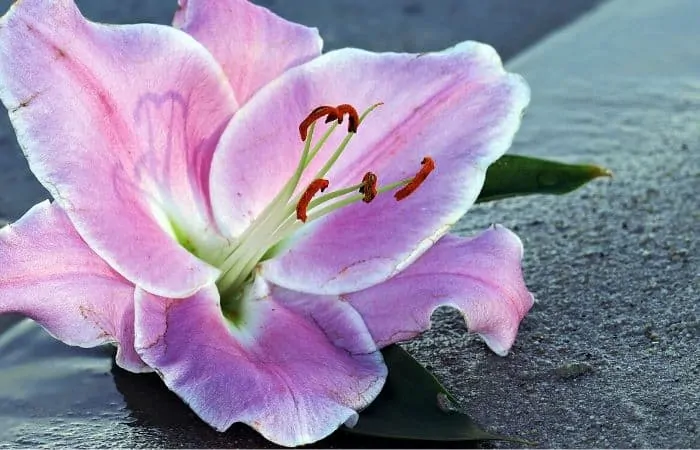Do you like Asiatic Lilies? I hope you do. These beautiful medium-sized flowers are a treat for the eyes. Lilium Asiatic is probably one of the easiest plants in this family to grow and maintain. These plants are very versatile with their accommodation. You can grow Asiatic lily anywhere in USDA zone 2 through 9. It can also survive in hot USDA zone 10 with little care. Today in this article we will discuss How to Dig up Asiatic Lily Bulbs? Proper maintenance of Lily bulbs from digging to sowing is more important than growing these plants. Therefore I invite you to join today’s discussion and share your thought with other readers. Check out these Asiatic Lily Bulbs, hope you will like some for your garden.

Check out my Previous Post: How to Divide and Grow Oriental Orange Tiger Lily?
Is it easy to dig up Asiatic Lily Bulbs?
Yes, It is pretty easy to dig out Lilium bulbs especially if you have any prior experience. Don’t worry it’s not rocket science. You just have to take out those bulbs without damaging them. After that let them dry out a bit and store them in cool dark well-ventilated storage areas.
It is easy though it will need some dedication and knowledge with the timing. Other than that, You may need a trowel to dig out the Lilium bulbs.
Buy beautiful Asiatic Lily Bulbs on Amazon.
Do I need to dig up Asiatic Lily Bulbs?
No, it is not necessary to dig out Asiatic Lily bulbs every year. In fact, you can let them grow and thrive for years until they occupy the entire available space. Sometimes digging out those bulbs is necessary just to prevent them from damage.
Digging bulbs out of the ground is necessary for further propagation of Asiatic lily. So if you want to grow another batch of Asiatic lilies in your garden or in a container then you should dig them out. Usually, a container will get crowded with many Lilium bulbs within 3 years. Therefore have a look at the flower quality and available growing space in the container. If the blooms look inferior and the bulbs appear to shift out of soil then it’s time to dig out and separate those Asiatic lily bulbs.
What to do with Asiatic lily bulbs after flowering?
The blooming season of the Asiatic lily is pretty small compared t its plant life. An Asiatic lily bulb sprouts in late fall and the plant lasts throughout summer. So it’s a pretty long time frame or growth period. The blooming period is limited to late spring till mid-summer. This probably lasts for a couple of months. After that, the plant won’t bloom. Instead, it will feed the bulbs underground and help them to grow bigger and stronger.
Therefore, It is better to let the Asiatic Lily plants stay in their growing spot until they turn yellow-brown on their own. Usually, the plant will turn yellow and then complete brown at the end of summer. This is the time when you should cut back the foliage to 3 inches above the ground.
Let it settle for a couple of days. Once the soil and plant dry out completely then dig out those bulbs. If the Asiatic lily plants are in your garden then there is no need for digging the bubs.
Simply let the plant die on its own after flowering ends. Feed the plant once or twice a month and slowly reduce watering. It will help the bulb to grow and finally acclimatize with the coming winter.
Also read: How to Safely Dig out Lilies?
When to dig up Asiatic Lily Bulbs?
You should dig out Asiatic lily when the plant seems dead. Its foliage will turn pale yellow or brown. Asiatic lilies usually stay green till late summer. Afterward, the foliage starts yellowing, and eventually, the plant will die back to the ground. This is the best time to dig up those Lily bulbs.
Don’t hurry with bulb digging or else it may die. If you dig out bulbs before they get dormant then they may lose their integrity. Those bulbs may rot or get infested with bugs or fungal spores. This is something no one wants to see.
You should dig up Asiatic lilies from late August till October. Adjust this timing according to your local climatic conditions. The temperature should remain around 60 degrees and keep falling day by day during bulb collection. The gradual temperature drop will force dormancy to the bulbs. It initiates the natural biological clock of the bulbs to sprout once the temperature rises again in spring.
Lily bulbs usually start root in late winter or early spring. So fall is the right time to dig out the bulbs and prepare your new flower bed. Sow the Bulbs before frost in a nonfreezing zone i.e, where snowfall is not very heavy during winter. Otherwise, wait till spring to sow the Asiatic lily bulbs. It will sprout back to life at a temperature above 55 degrees Fahrenheit.
Special Precautions before Digging Asiatic Lily Bulbs
- You should wait until the plant dies back to the ground. It is not healthy for the plant to dig out bulbs before they become dormant.
- Stop watering the bulbs at least 2 weeks before Digging else the bulbs may root or catch a fungal infection.
- Use a clean and sharp trowel to dig out the Asiatic lily bulbs. Treat your tools with rubbing alcohol to reduce the chances of disease spreading.
- Discard any infected bulb as soon as you find a sign of fungal or bacterial infection. Proper care is required with the disposal of these bulbs. Infected bulbs can damage any healthy bulb in contact. So through them away from your lily patch.
You should also read this: How to Grow a Charity Plant, Jacob’s Ladder Plant?
How to Safely dig up Asiatic Lily Bulbs?
- Start with timing the stalk and foliage at the end of the growing season. Wait for the plant to turn yellow and then cut it back to 3 inches above the surface. This 3-inch head will help in the identification of the central bulb.
- Let the topsoil dry for a couple of days. Less foliage around the base will help in aeration and proper evaporation.
- Push a sharp clean trowel slowly beneath the bulb. You have to estimate the bulb size before shoving the trowel in the soil. A healthy Asiatic lily bulb may occupy a 3 to 4-inch wide area in the soil. Also, it may scale up to 4inch deep. So keep a 2-inch margin around the bulb diameter and push down the trowel below the bulbs. Don’t worry if some of the roots get chopped. They will grow back again in the spring.
- Brush f these bulbs and let them dry in partial shade for a couple of days. It will remove excess moisture and first. This will prevent chances of a fungal attack.
- You can also rinse the bulbs with water and fungicide solution. Although it is not necessary. If you try this then don’t forget the carefully dry out the water from the bulb’s surface else it can cause rotting.
- Store the Bulbs in cool dry well-ventilated storage areas. Onion nets or wooden racks are perfect to the shelf these beautiful lily bulbs. Use contact fungicide as an extra precaution for fungal disease.
- Keep a habit of regular checkups to make sure the bulbs stay healthy and free from disease in the storage.
- Finally, prepare the soil for the new plant and sow these bulbs 2 to 3 inch deep beneath the soil. Keep the soil moist but not soggy and place it in full sun for a couple of weeks. Usually, Springtime is ideal for Asiatic lily bulb germination. Wait for the temperature to rise above 55 degrees and then sow the bulbs in the soil mix.
- Your new Asiatic lily plant will be ready to bloom in a couple of months and the cycle continues.
Final Words
Asiatic lily plants can thrive anywhere from Zone 2 to 9 and they won’t require much attention. Only care for proper timing while digging up the bulbs. And yes, it is not necessary to dig out the Lilium bulbs every year unless you want to grow them somewhere else. It is always easy and convenient to let those bulbs in the ground unless they are super crowded. They will keep growing and blooming in the same spot for years. Once you find degradation in bloom quality then you should consider shifting those bulbs to a new location.
Dig out the Asiatic lily Bulbs during fall and Sow them early in spring. They will sprout in 3 to 4 weeks at an ideal 55 to 60 degrees Fahrenheit. Meanwhile, keep feeding and nurturing these beautiful plants. Trust me you won’t regret it. Your efforts will be rewarded with lots of beautiful blooms in the spring season.
Write down your thoughts on How to Dig up Asiatic Lily Bulbs? and Keep reading, Keep Gardening!


I have dug up a compact plot of these lily bulbs with the aim of replanting them elsewhere. I live in the San Francisco Bay area. Question for you: should I peel back the old “skin” from the bulbs?
Thanks,
Tom
Hi Tom,
There is no need to peel off old skin from tulip bulbs. Dry old skin is helpful for protection against bugs and other natural factors. Simply place them in a good soil mix, and care for the essential warmth and moisture. The rest will be handled by nature, just wait and enjoy gardening.